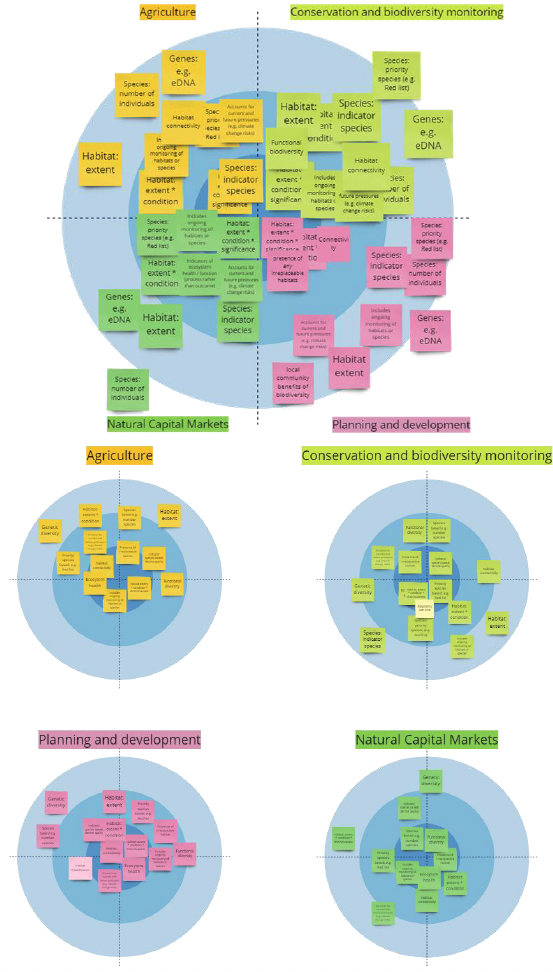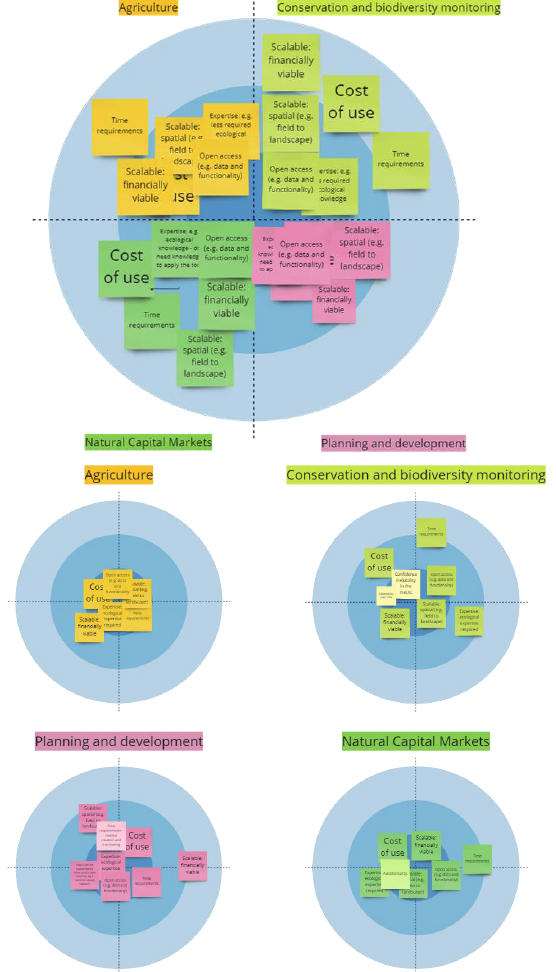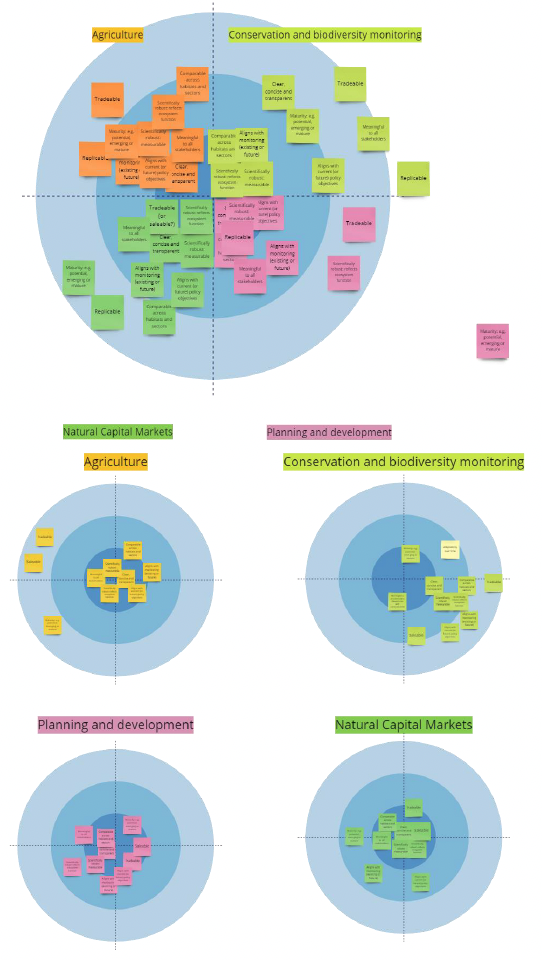Measuring biodiversity: research into approaches
This report considers methodologies for measuring biodiversity at site-level for use in Scotland.
Annex 3 Assessment Criteria Workshop Results
Habitat and species
Our assessment of criteria split habitat and species-based metrics into their constituent elements. The aim being to explore the relative priority for different approaches across the policy areas. Habitat based metrics can be of differing levels of complexity ranging from habitat extent; both extent and condition; or interacting extent, condition and significance (or distinctiveness). Similarly, species-based metrics could comprise of number of individuals; indicator species; or priority species (e.g. set nationally or IUCN Red List). Where species are not the explicit basis of the metric, they may be included in habitat condition assessments, for example in terms of richness (number of species) or as indicators of good or poor condition. We also initially included 'genes' as category for the metric, this is more complex and genetic tools such as environmental DNA (eDNA) can be used to help detect the presence of particular species (e.g. when surveying may be difficult), to estimate the diversity of species (e.g. soil microorganisms). However, eDNA may be considered a means of estimating species richness, or detecting the presence of indicator species, rather than a metric in its own right. The discussion during the steering group workshop determined that this category should instead reflect genetic diversity within a population of a species (i.e. through gene sequencing), with high genetic diversity typically indicating greater resilience to environmental change.
Further criteria included whether the metric includes ongoing monitoring of habitats and species or accounts for current and future pressures, for example, this might include the impacts of climate change, and emergence of new pests and diseases.
Table 17 and Figure 14 summarises the results of the criteria assessment for habitats and species metrics. Criteria were sorted into three categories from highest to lowest priority based on the relative placement of sticky notes on the target. Habitat based metrics that combined habitat extent, condition and distinctiveness were prioritised across all policy areas except for natural capital markets. A comment from the Conservation and Biodiversity Monitoring group noted that this metric was important as it is practical and achievable.
| Policy Area |
High Priority |
Medium Priority |
Low Priority |
|---|---|---|---|
| Agriculture |
|
|
|
| Conservation and Biodiversity Monitoring |
|
|
|
| Planning and Development |
|
|
|
| Natural Capital Markets |
|
|
|

The presence of irreplaceable habitats (e.g. ancient woodland) was added during the steering group workshop, this also proved to be of high priority across three of the policy areas (i.e. excluding Planning and Development). Clearly irreplaceable habitats are of high importance to the Planning and Development sector and their presence is accounted for in decision making. Such habitats are, however, protected through legislation and in requiring bespoke compensation and are not tradeable. This could account for this sector giving irreplaceable habitats a lower priority.
Agriculture and Natural Capital Markets prioritised ongoing monitoring. Ecosystem health and functioning was added in the steering group workshop, this was split into ecosystem health and functional diversity for the second workshop. Ecosystem health was given a high priority by all areas, with functional diversity generally considered as of medium priority. It was commented that some measure of below ground functional diversity would be useful across different habitats. Planning and Development was focused on habitat extent and condition to a greater extent than the other policy areas.
Habitat connectivity was added by the steering group participants and rated as high or medium priority across policy areas. Discussions indicated the importance of connectivity in establishing nature networks across Scotland. The lack of interaction of different habitats (e.g. agriculture and forestry) was noted indicating that connectivity needs to be considered beyond the local abundance of similar habitats.
Habitat extent (in contrast to also including condition and distinctiveness) was given a lower priority across each of the policy areas. Genetic diversity was also given a low priority across three areas (i.e. excluding Conservation and Biodiversity Monitoring).
Effort and ease of use
The assessment of required effort and ease of use is summarised in Table 18 and Figure 15. Most of the metrics are open access, using publicly available data and methods. Some have an open access methodology, but charge for access to data (IBAT and STAR). Others such as NARIA use proprietary models. However, open access metrics may still require expertise in understanding the data or undertaking the biodiversity impact calculations. For tools such as Biodiversity Metric 3.1, use of the tool such as a spreadsheet user-interface may not require specific expertise, but there may be expertise required in the collection of underlying data such as habitat condition assessment.
Most of the metrics were able to be scaled either in terms of their spatial scale or without entailing disproportionate costs. The IBAT and STAR tools are partially scalable in financial terms as assessments over larger or more numerous sites entail larger data purchase fees. The BMS and BPT metrics
| Policy Area |
High Priority |
Medium Priority |
Low Priority |
|---|---|---|---|
| Agriculture |
|
|
|
| Conservation and Biodiversity Monitoring |
|
|
|
| Planning and Development |
|
|
|
| Natural Capital Markets |
|
|

are designed to be used at farm level, consequently there was no information on scaling costs, and spatial scalability was limited as the indicators used in these tools may be location specific.
Very few of the metrics provided information on the time requirements or costs of use. BPT provides an estimate of per farm assessment costs. BIRS is intended to be both time and cost efficient. The IBAT and STAR website provide information on subscription costs for access to their datasets.
Useability and comparability
The third exercise considered broad criteria relating to useability and comparability. By useability we mean the outcomes of a metric or tool in terms of addressing end-user needs rather than the use of the metric itself to calculate a measure of biodiversity. The results of the Miro board sorting are show in Table 19.
Clear, concise and transparent was the only criterion that was given the highest priority across all policy areas. Scientifically robust in terms of measurability was given the highest priority in three of the policy areas (i.e. excluding Conservation and Biodiversity Monitoring). There was a contrast with respect to tradeable and saleable between the Planning and Development and Natural Capital Markets groups on one hand and the Agriculture and Conservation and Biodiversity Monitoring groups on the other. The former group gave a high priority to saleable. This was a further criterion added with respect to Natural Capital Markets in the steering group workshop and is distinct from tradeable in that it relates to the potential to sell biodiversity 'units' rather than trading biodiversity gains in one habitat or area for loss elsewhere (e.g. a net gain calculation). It should be noted that the high priority given to both tradeable and particularly saleable by the Planning and Development group does not reflect Scottish planning policy as set out in National Planning Framework 4. Net gain or nature positive development requires some degree of comparability between different habitat types, i.e. the impacts of development on one habitat type needs to be compared to compensating action in another. Whereas there is an active debate in policy regarding the fungibility of nature with respect to ecosystem markets, in that different habitats are not comparable. This reflects unease around commodification. Where comparability is required is with respect to ecosystem level outcomes.
| Policy Area |
High Priority |
Medium Priority |
Low Priority |
|---|---|---|---|
| Agriculture |
|
|
|
| Conservation and Biodiversity Monitoring |
|
|
|
| Planning and Development |
|
|
|
| Natural Capital Markets |
|
|

Contact
Email: katherine.pollard@gov.scot
There is a problem
Thanks for your feedback